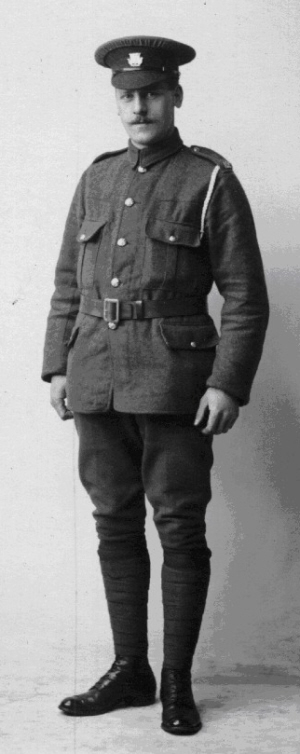
Gerald Emil Wilson was born on the 12th August 1887, the third son and fifth child of Ossett mill engineer James Wilson and his wife, Mary Annie (nee Northing), who had married at St. Lawrence’s Church, Corringham, Lincolnshire on the 4th December 1878. Mary Annie was the youngest child of Corringham corn miller and farmer, Henry Northing. James and Mary Annie Wilson went on to have twelve children, but one son, Arthur Edward, died aged 7 months in 1890. For many years, James and Mary Annie Wilson lived at Moorcroft Cottage, nearly opposite Ossett Holy Trinity Church.
Gerald Wilson, aged 25 years married 23 year-old Annie Eliza Green on the 19th August 1912 at South Ossett Parish Church. Annie was the daughter of Wakefield policeman Charles Harry Green. The couple went on to have three children: Kenneth, born 1918, Roland, born 1923 and Marion born 1926.
Gerald Emil Wilson died in April 1971 aged 83 years. He was the much-loved grandfather of the co-author of this WW1 Remembrance Project, Stephen Wilson.
“Military Medal Awarded For Bravery – The Military Medal has been won by another popular Ossett soldier, namely, Private Gerald E. Wilson, Duke of Wellington’s Regiment, who used to live in Headlands-road, and is a son of Mr. James Wilson, of Moorcroft-street. At the time he joined the army about three years ago, he was employed in the central grocery department of the Ossett Co-operative Society. He first went to the Western fighting front in September, 1917, but a few months later returned to England suffering from septic poisoning. In March last, he again went to France, where he won his distinction, while acting as a runner with messages from the troops as they advanced. In a letter home he says he has had experiences enough to last him a lifetime. On one occasion it took him twenty minutes to go a distance of 100 yards, as he had to dodge machine-gun fire, and then one dark, moonless night, when it was pouring with rain, he fetched ammunition. He kept tumbling over discarded equipment, dead bodies, shell holes, etc., and was about ‘done up’ when he got the ammunition party back. However, he had the satisfaction of knowing that he had done what was expected of him and the captain recommended him for a decoration. A week ago he was presented with the ribbon of the medal. A younger brother, Edwin, is serving with the Navy.” 1
After the end of WW1, the award of the Military Medal to Private Gerald E. Wilson was gazetted:
“To 17112, Private Gerald Wilson – I beg to inform you that the Corps Commander under authority granted him has awarded you the Military Medal for the following act of gallantry in the field. During operations near Fresnoy on November 4th 1918, this soldier acted as Company Runner. Throughout, he was a magnificent example of devotion to duty and utter fearlessness. He carried messages backwards and forwards to Battalion HQ under very heavy artillery and machine gun fire. On many occasions he located elements of his Company who had lost direction and guided them back to the Company. He worked extremely hard all the time and delivered all messages in the shortest possible time under very heavy fire. A very gallant soldier.
H Lyles, Captain and Adjutant, 5th Duke of Wellington’s Regiment, Ossett, January 18th 1919″ 2
Private Gerald Wilson won his Military Medal at the Battle of the Sambre Canal, near Catillon, France on the 4th November 1918. This was a large British (1st, 3rd and 4th Armies) and French offensive on a 30-mile front from east of Scheldt at Valenciennes to Guise on Oise, reaching to east of Le Quesnoy, half way through Mormal Forest, past Landrecies on Sambre and across Sambre-Oise Canal. 10,000 German prisoners and 200 guns were captured.
References:
1. “Ossett Observer”, 14th December 1918
2. “London Gazette”, 23rd July 1919 – Page 9374.